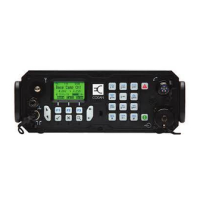AES-256 digital voice encryptor option
Manpack Transceiver 2110 series Reference Manual 303
Creating a text file containing AES secure keys
As a system administrator, you can program a group of secure keys into a transceiver by
creating a text file containing the information, then sending this text file to the
transceiver using a terminal-emulation program (see page 304, Setting up
communication with the computer and page 305, Programming the transceiver).
Figure 50: Example of a text file containing AES secure keys
NOTE
You may also use Codan’s Key Management Software to generate secure
keys and to fill the AES-256 digital voice encryptor. This software
provides enhanced security for the key set. This prevents the keys from
being read by a text editor, and in some instances, prevents the key set
from being programmed to unauthorised transceivers.
NOTE
You can send each line to the transceiver via a terminal-emulation
program. You must be logged in to admin level to send certain secure
commands from a computer to the transceiver (see page 128, Logging in
to admin level). Alternatively, you can enter these commands into the
RS232 Startup entry in the Control List (see page 265, RS232 Startup
entry).
NOTE
You must enter a password to log in to admin level. If the transceiver does
not use an admin password, leave a blank line in the text file so that an
empty admin password is used.
NOTE
The echo off command prevents the secure keys being written to the
buffer of the terminal-emulation program.
CAUTION
You must use a hard return at the end of each line, including the last line,
so that the command is executed as it is sent to the transceiver.

